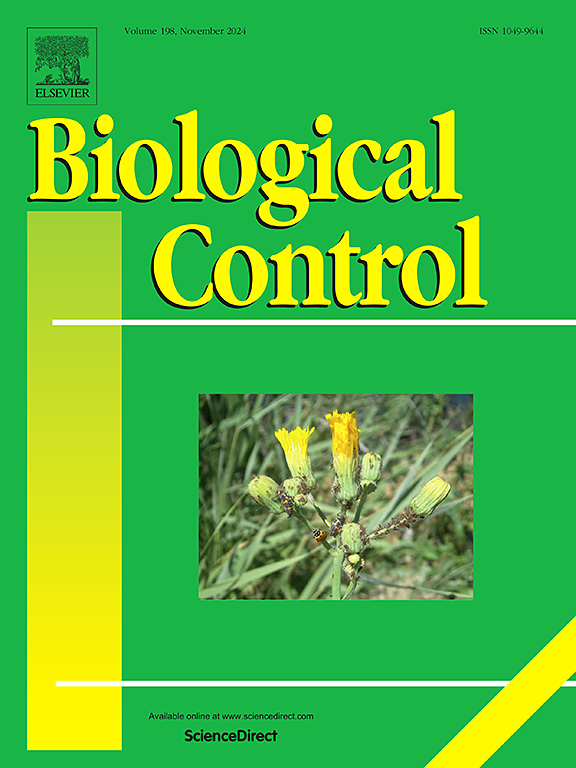单用紫紫紫菌及联用金龟子绿僵菌的生物防治(蜱螨:伊螨科)
IF 3.7
2区 农林科学
Q2 BIOTECHNOLOGY & APPLIED MICROBIOLOGY
引用次数: 0
摘要
鉴于蜱类雕刻性弱视虫传播引起巴西斑疹热的病原体立克次体立克次体,它具有重大的公共卫生利益。水豚是这种外寄生虫的主要宿主,也是这种细菌的天然宿主。为了寻找新的控制蜱虫的方法,本研究评价了紫丁香紫芽孢菌(IBCB 130)单独和联用绿僵菌(IBCB 425)的田间防治效果。两个面积为5000 m2的区域(Pl和MaPl)用于真菌水悬浮液的施用,每月一次,为期11个月,还有一个控制区不接受任何施用。在Pl区以6 × 1011分生菌/ha的浓度施用紫丁香假单胞菌;两种真菌(紫丁香假单胞菌3 × 1011分生孢子/公顷,金银桃假单胞菌1 × 1013分生孢子/公顷)联合施用于MaPl地区。每次施用一周后,通过放置在植被上的二氧化碳吸引陷阱收集蜱虫。然后统计每个陷阱中的蜱虫总数,并从每个区域分离出最多16只蜱虫(成虫和若虫),并单独分布在池中。这些被保存在28°C和80%相对湿度的气候控制室中。在第5、10和15天,评估蜱(个体和池中)的死亡率。在统计分析中使用Fisher精确检验来确定处理区域的种群减少,使用来自每个区域的数据,根据仙女或成虫占优势(epoch, Ep)或不占优势(non-epoch, NEp)的时期。在第15天的评估中,对单独饲养的成蜱的死亡率分析显示,Pl区为46%,MaPl区为44%,对照区为31%。在合并的成年鼠中,Pl的死亡率为55%,MaPl为31%,对照为25%。成虫期蜱虫种群减少率为:白蛉为69%,白蛉为69.6%,对照组为7.4%。单独饲养的若虫15天死亡率分别为68%、58%和60%;池中若虫的成虫率分别为92%、93%和35%。这些结果表明,两种处理均能显著减少紫丁香双生菌的种群数量,且单施pll的真菌量低于施用MaPl的真菌量。根据所获得的结果,本研究表明,使用真菌P. lilacinum形成了一种有效的替代生物防治A. sculptum。本文章由计算机程序翻译,如有差异,请以英文原文为准。
Biological control of the tick Amblyomma sculptum (Acari: Ixodidae) using the fungus Purpureocillium lilacinum alone and in association with the fungus Metarhizium anisopliae
The tick Amblyomma sculptum is of major public health interest given that it transmits the bacterium Rickettsia rickettsii, the pathogen that causes Brazilian spotted fever. Capybaras are primary hosts for this ectoparasite species and natural reservoirs for this bacterium. With the aim of finding new means for controlling this tick, the objective of this study was to evaluate the efficacy of the fungus Purpureocillium lilacinum (IBCB 130) alone and in association with the fungus Metarhizium anisopliae (IBCB 425), in the field. Two areas of 5000 m2 (Pl and MaPl) were used for applications of aqueous suspensions of fungus, once a month over an 11-month period, and there was also a control area that did not receive any application. The fungus P. lilacinum was applied in the area Pl at a concentration of 6 x 1011 conidia/ha; and an association of the two fungi (3 x 1011 conidia/ha for P. lilacinum and 1 x 1013 conidia/ha for M. anisopliae) was applied in the area MaPl. One week after each application, ticks were collected by means of CO2 attraction traps that were laid out on the vegetation. The total number of ticks in each trap was then counted and up to 16 individuals (adults and nymphs) from each area were separated out and distributed individually and in pools. These were kept in climate-controlled chambers at 28 °C and 80 % relative humidity. On days 5, 10 and 15, mortality among the ticks (individually and in pools) was assessed. Fisher’s exact test was used in statistical analysis to ascertain the reduction in population in the treated areas, using data from each area according to periods when either nymphs or adults of A. sculptum predominated (epoch, Ep) or there was no predominance (non-epoch, NEp). The mortality analysis on adult ticks that were housed individually showed percentages of 46 % for area Pl, 44 % for area MaPl and 31 % for the control area, in the evaluation of the 15th day. For the pooled adults, the percentage mortality was 55 % for Pl, 31 % for MaPl and 25 % for the control. The percentage reduction in population for ticks in the adult phase was 69 % for Pl, 69.6 % for MaPl and 7.4 % for the control. For nymphs housed individually, the 15th day mortality was 68 % for Pl, 58 % for MaPl and 60 % for the control; while for the nymphs in pools, the percentages were 92 %, 93 % and 35 % for Pl, MaPl and control, respectively. These results indicate that the areas over which the fungus P. lilacinum was applied presented considerable reductions in population through both treatments, with a lower dosage of fungus in the application of Pl alone than in the application of MaPl. In the light of the results obtained, this study suggests that use of the fungus P. lilacinum forms an effective alternative for biological control of A. sculptum.
求助全文
通过发布文献求助,成功后即可免费获取论文全文。
去求助
来源期刊

Biological Control
生物-昆虫学
CiteScore
7.40
自引率
7.10%
发文量
220
审稿时长
63 days
期刊介绍:
Biological control is an environmentally sound and effective means of reducing or mitigating pests and pest effects through the use of natural enemies. The aim of Biological Control is to promote this science and technology through publication of original research articles and reviews of research and theory. The journal devotes a section to reports on biotechnologies dealing with the elucidation and use of genes or gene products for the enhancement of biological control agents.
The journal encompasses biological control of viral, microbial, nematode, insect, mite, weed, and vertebrate pests in agriculture, aquatic, forest, natural resource, stored product, and urban environments. Biological control of arthropod pests of human and domestic animals is also included. Ecological, molecular, and biotechnological approaches to the understanding of biological control are welcome.
 求助内容:
求助内容: 应助结果提醒方式:
应助结果提醒方式:


